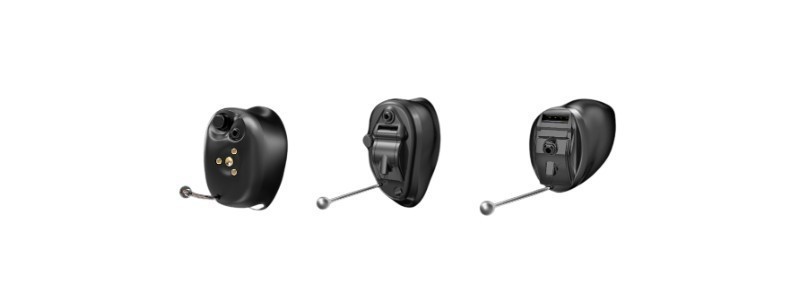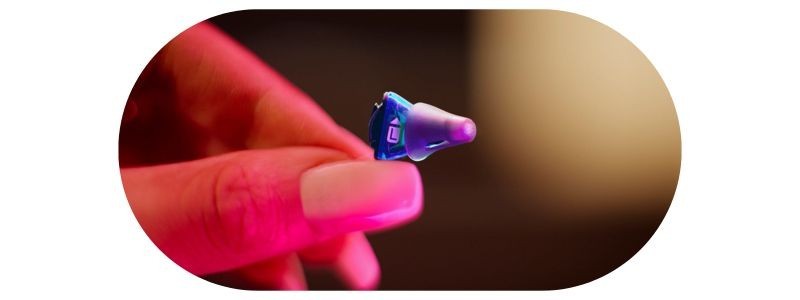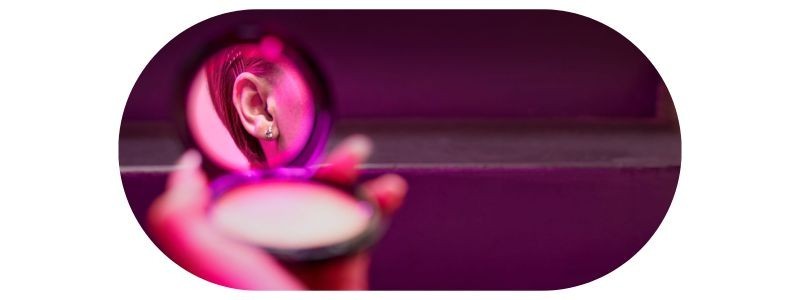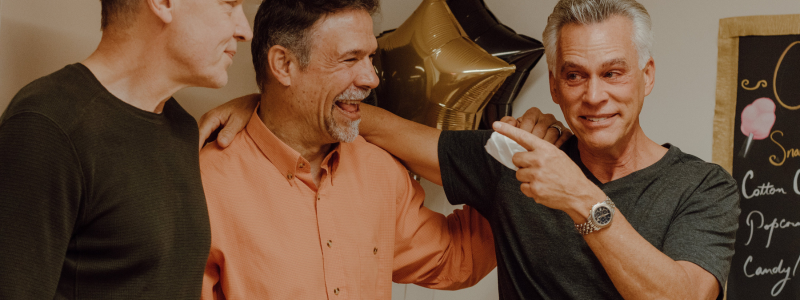
Head of Online Medical Content

Audiology Expert
The World's Smallest Hearing Aids of 2026
Exploring the invisible, small, and discreet hearing aids available in the UK
What are small hearing aids? | What's available? | Are small hearing aids right for everyone? | Pros and cons | Conclusion
Last Hearing Aid UK Update:
Overview
Let's be honest about why you're reading this page: you need hearing aids, but you're worried about how they'll look. Perhaps you think they'll make you seem older, or you're embarrassed about needing them, or you simply prefer things that are discreet.
These are completely normal feelings, and frankly, we hear them every single day.
This article highlights the smallest hearing aid available in the UK. Designed for mild to moderate hearing loss, these custom-fit, nearly invisible devices offer comfort, clarity, and discretion.
Before we dive into specifics, here's something important to understand: whilst invisible hearing aids can be brilliant for the right person, they're not always the best choice even if discretion is your priority.
We'll explain why honestly, because our job is to help you hear better, not just to sell you what you think you want.
It also compares in-ear styles (ITE, CIC, IIC), outlining their pros and cons. While ideal for discreet wear, invisible hearing aids may lack features like Bluetooth and are not suitable for severe hearing loss.
The key is finding the right balance between discretion and performance - and that balance is different for everyone.
Which is the smallest hearing aid available?
To date, the smallest hearing aids available are the Starkey Signature Series CIC R NW hearing aids. Powered by the Genesis AI platform, these custom, next-generation, wireless hearing aids offer excellent sound quality whilst remaining almost completely invisible.
These are genuinely remarkable devices - sitting deep in your ear canal where even your hairdresser wouldn't notice them. But here's the important bit: "smallest" and "best for you" aren't always the same thing.
These custom-fitted, invisible models are ideal for mild to moderate hearing loss but may not work for severe cases.
They provide comfort, better sound quality, and improved speech understanding, though they lack advanced features like Bluetooth and have shorter battery life.
This is the trade-off we need to talk about honestly: maximum discretion often means compromising on features that could genuinely improve your daily life.

Discrete hearing aid styles are becoming more popular
Invisible hearing aids are small hearing solutions that cannot be seen outside your ear. This is because they sit deep inside your ear canal and are generally custom-fit. So you will benefit from both a personalised hearing experience and a comfortable fit, unique to your ear shape.
Custom-fitting isn't just marketing speak - we take impressions of your ear canal, and the hearing aids are manufactured specifically for you. It's rather like having bespoke suits made for your ears, which is why they're so comfortable when fitted properly.
If discretion and comfort are your priority, then invisible hearing aids are worth considering. In this article, we go through the features, benefits, and impact of invisible hearing aids on hearing health.
More importantly, we'll help you understand whether discretion should actually be your main priority, or whether slightly larger aids with better features might serve you better in the long run.
What are invisible hearing aids?
Invisible hearing aids, also known as In-the-Canal (ITC) hearing aids or Completely-in-the-Canal (CIC) hearing aids, are designed to be as discreet as possible.
This means that they are not noticeable to others when being worn, potentially giving wearers more confidence and comfort in social situations.
And we do mean genuinely not noticeable - we've had patients whose own families didn't realise they were wearing hearing aids for weeks.
Many people with hearing loss are concerned about the devices themselves being too conspicuous. This concern is completely understandable, but we need to have an honest conversation about it.
We know that looking after your hearing health is the most important, but confidence is also key, and often being self-conscious about wearing your hearing aids affects that.
Here's something we wish more people understood: the social impact of constantly asking "what?" or missing conversations is often far more noticeable than wearing modern hearing aids. People notice when you're struggling to hear - they rarely notice well-fitted hearing aids.
In some cases, it is the reason why so many people do not seek professional help with their hearing loss in the first place. With every year that goes by (and the smaller hearing aids become), we hope this inspires change.
The irony is that delaying treatment often means you need more powerful (and therefore larger) hearing aids eventually. Getting help earlier usually means you can use smaller, more discreet options.
What small hearing aids are available today in the UK?
Small and discreet hearing aids are broken down into different In-Ear categories. Let's walk through these from most visible to least visible - though honestly, even the "most visible" of these are still quite discreet. These are:
- ITE hearing aids: In-the-Ear hearing aids are quite small and, as the name suggests, sit just in the ear canal. They can still be seen but are far more discreet than the Full Shell or Half Shell aids (ITC). Some manufacturers also offer colours to match hair or skin tones.
They are less visible than traditional hearing aids but may be noticeable to others if they are looking closely.
In practical terms, someone sitting directly across from you at dinner might notice them if they look carefully, but most people in your life probably won't. And frankly, most people are too preoccupied with their own concerns to notice anyway.
- CIC hearing aids: Completely in the Canal (CIC) hearing aids sit further into the canal and are almost unnoticeable. They are almost completely hidden from view and are not visible when worn.
These are the sweet spot for many people - genuinely discreet without sacrificing too much in terms of features and battery life.
- IIC hearing aids: Invisible in the Canal hearing aids are the most discreet type of hearing aid and are designed to be virtually invisible when worn. They are custom-made to fit deep inside the ear canal and are only visible if someone is looking directly into the ear.
We mean really directly - even your partner probably won't notice them unless they're specifically looking inside your ear canal, which hopefully doesn't happen often.
A reality check about modern hearing aids
Before you commit to invisible aids purely for discretion, let's talk about how discreet modern behind-the-ear aids have become. Today's RIC (Receiver-in-Canal) hearing aids are remarkably small and subtle - often barely visible behind your ear, especially if you have longer hair or wear glasses.
They also typically offer better sound quality, longer battery life, Bluetooth connectivity, and more sophisticated features.
We've had countless patients come in absolutely certain they want invisible aids, try both styles during their fitting, and choose the slightly larger RIC aids because the performance difference was so noticeable.
That's the honest truth - and it's why we offer free trials with our 60-day money-back guarantee, so you can make an informed decision based on real-world experience, not just assumptions.

Small, Invisible and Discreet Hearing Aids
Are invisible hearing aids any good?
Are invisible hearing aids suitable for everyone?
The honest answer here is no. And we need to be rather direct about this because choosing the wrong style - even if it's more discreet - can mean you don't wear your hearing aids regularly or don't get the benefit you need.
If you are conscious about wearing hearing aids like Receiver in the Canal (RIC) or Behind the Ear (BTE) models, then - yes - invisible devices might be worth considering and opting for. However, they are not appropriate for everyone or every ear.
ITE hearing aids are generally compatible with people who have mild to moderate hearing loss. Because they are small, they are not suitable or recommended for people who have severe to profound hearing loss.
If your hearing loss is more significant, invisible aids simply can't provide enough amplification. It's rather like trying to power a large house with a small battery - the physics just doesn't work.
They are also much trickier to handle and put into your ear, or they can be a challenge when you replace your batteries. So if vision or dexterity is an issue, this type of hearing aid is probably not the best style for you.
We see this quite often with older patients who choose invisible aids for vanity reasons, then struggle with the tiny batteries and fiddly insertion. It's frustrating for everyone involved, and entirely avoidable with an honest conversation up front.
The dexterity question is genuinely important - if you have arthritis, tremors, or simply struggle with small objects, you'll find invisible aids annoying to handle daily. There's no shame in admitting this; it's just a practical reality.
A slightly larger aid that you can actually manage is infinitely better than a tiny aid gathering dust in a drawer.
Are small and invisible hearing aids available on the NHS?
Quite a lot of consumers choose to go private for their hearing aids to benefit from a more discreet in-the-ear device, which is historically not as available on the NHS, if not at all.
The NHS provides excellent basic care, but its hearing aids are typically BTE models. If discretion is genuinely important to you, private audiology is usually necessary.
The latest and most modern hearing aids that private audiologists have to offer, such as advanced technology, mobile compatibility, and sophisticated Bluetooth connectivity.
And because we're truly independent - not affiliated with any manufacturer - we have access to the full range of options. We can show you what's genuinely most discreet versus what offers the best balance of discretion and performance for your needs.
Ear shape is a factor when thinking about small hearing aids
Comfort is so important when choosing hearing aids. If they are a bad fit, they won't just deliver poor sound, but they will also hurt your ears and cause irritation. Invisible hearing aids are known to be comfortable, but they are not compatible with all ear shapes.
Here's where anatomy matters more than you might think. Your ear canal might be too narrow, too curved, or simply not shaped in a way that accommodates deep-insertion aids. This isn't a failing on your part - it's just how you're built.
For instance, if your ear canals are short or thin, an ITE hearing aid may not sit comfortably within your ears. However, there are options to try this style of hearing aid before you commit to purchasing with your audiologist, which we would highly recommend.
This is exactly why we offer free home visits and proper assessment before you commit to anything.
We can take impressions, assess whether invisible aids will work well for your ear anatomy, and give you honest advice - even if that advice is that slightly larger aids would serve you better.
Wax production is another factor people don't consider - if you produce significant earwax (which is completely normal), invisible aids sitting deep in your canal can get blocked more easily, requiring more frequent cleaning and maintenance.
It's not a dealbreaker, but it's something to consider when weighing your options.

Invisible and Small Hearing Aids Pros and Cons
What are the advantages and disadvantages of invisible hearing aids?
What are the advantages of invisible hearing aids?
Let's be completely frank about both the benefits and the compromises involved. Invisible hearing aids can be brilliant for some people and completely wrong for others - often for reasons that have nothing to do with vanity or appearance.
Invisible hearing aids have several features and benefits, the main ones include:
Discretion
The main advantage of invisible hearing aids is that they are not noticeable to others when being worn. Being placed inside the ear canal, they are virtually invisible to others, addressing the stigma associated with wearing visible hearing devices.
This can be particularly important for people who are self-conscious about their hearing loss or who do not want others to know that they are wearing a hearing aid.
We completely understand this concern, even if we wish the stigma around hearing aids didn't exist. Your feelings about this are valid, and if discretion gives you the confidence to actually wear your hearing aids consistently, then that discretion has genuine value.
However, we also want to gently challenge the assumption that people will judge you for wearing hearing aids.
In our experience, people are far more likely to judge - or simply avoid - someone who constantly misses conversation, interrupts inappropriately, or withdraws from social situations due to hearing difficulties.
Modern hearing aids are increasingly seen as smart technology, rather like wearing wireless earbuds.
Comfort with customisation and fitting
Invisible hearing aids are generally more comfortable to wear than traditional hearing aids, as they do not have any visible parts that can rub against the skin or get caught in the hair.
No parts behind your ear means nothing to interfere with glasses, hats, or hairstyles - this matters tremendously to some people.
In regard to fit, audiologists take impressions of the wearer's ear canal, ensuring a perfect fit. This personalised fitting contributes to enhanced comfort and reduced chances of discomfort or feedback, making them ideal for extended wear.
When we say "perfect fit," we mean it - these are manufactured specifically for your unique ear anatomy. It's precision engineering, and when done properly, you genuinely forget you're wearing them.
Improved sound quality
Because they are located closer to the eardrum, invisible hearing aids can provide better sound quality than traditional hearing aids. They are also less prone to feedback (whistling) than traditional hearing aids, which can be a common issue for people with severe hearing loss.
The proximity to your eardrum does offer acoustic advantages - sound doesn't have to travel as far, which can mean more natural sound quality.
Invisible hearing aids utilise sophisticated digital processing technology, allowing for advanced sound processing and noise reduction. These devices can adapt to various listening environments, delivering clear and natural sound to the wearer.
Though we should note that while the sound processing is sophisticated, it's often not as advanced as what's possible in larger hearing aids simply because there's less physical space for components.
Speech understanding
Speech understanding is crucial for communication, and invisible hearing aids are designed to prioritise this aspect. The proximity to the eardrum ensures that sound vibrations are accurately transmitted, leading to improved speech perception even in challenging listening environments.
For mild to moderate hearing loss - which is what these aids are designed for - speech understanding is generally excellent.
Compatibility with active lifestyles
Invisible hearing aids are an excellent option for individuals with active lifestyles. Whether they are engaged in sports, outdoor activities, or simply prefer a less obtrusive hearing solution, these devices offer a seamless fit and eliminate worries about their appearance.
Runners, cyclists, and gym-goers often prefer invisible aids because there's nothing to get caught on clothing or knocked off during activity. This is a genuinely practical advantage beyond just appearance.
What are the disadvantages of invisible hearing aids?
Small hearing aids come with certain limitations and considerations. While invisible hearing aids offer numerous benefits, they might not be suitable for everyone. This is where we need to be especially honest, because these disadvantages can significantly impact your daily quality of life.
Individuals with severe hearing loss may require more powerful devices, which might be challenging to fit into the small form factor of invisible hearing aids. Here are some of the main disadvantages of invisible hearing aids:
Features
Invisible hearing aids historically don't have the same feature catalogue as other styles. This is because of the size of the devices and not having enough room to store such technology. This means that invisible hearing aids have shorter battery life.
In practical terms, you might be changing batteries every 3-5 days rather than every 7-10 days, or you might not have rechargeable options at all. For some people, this is a minor inconvenience. For others, it's genuinely irritating.
The lack of advanced features also means missing out on things like automatic environment detection, sophisticated noise management in complex situations, and smartphone apps with extensive control options. Again, whether this matters depends entirely on your lifestyle.
Sound
Because invisible hearing aids sit inside your ear, the sound is collected and amplified. You don't have the assistance of directional microphones, which are hugely beneficial if you find a conversation in noise difficult to understand.
This is the biggest compromise, honestly. Directional microphones in behind-the-ear aids can dramatically improve your ability to focus on conversation in noisy restaurants or busy family gatherings. Without them, you're relying purely on your brain's ability to sort out speech from noise.
If you regularly find yourself in challenging listening environments - busy restaurants, crowded family events, noisy workplaces - this limitation could genuinely impact your quality of life. It's worth considering whether maximum discretion is worth struggling in these situations.
Connectivity
BTE hearing aids provide advanced Bluetooth connectivity for phone calls and streaming audio, and TV programmes. You might miss out on Bluetooth connectivity with most IIC or ITE hearing aids, so if this is important to you, then you need to look at other options.
In today's world, where many of us use smartphones constantly, video calls regularly, and stream music or podcasts, missing Bluetooth connectivity can feel like a significant step backwards.
Think about your actual daily life: Do you take phone calls? Do you watch television? Do you attend video meetings for work? Do you use your smartphone for navigation? If the answer to any of these is "frequently," then invisible aids without Bluetooth might frustrate you tremendously.
The honest conversation about trade-offs
Here's what we wish every person considering invisible hearing aids understood: modern hearing aid technology has advanced remarkably, but physics still imposes real constraints. Smaller devices mean smaller batteries, fewer microphones, less sophisticated processors, and reduced connectivity options.
For some people - those with mild hearing loss, simple listening environments, and minimal technology needs - invisible aids are perfect. They provide adequate amplification, they're comfortable, and the discretion genuinely matters.
For others - those with more complex hearing loss, challenging listening environments, or who want smartphone connectivity - slightly larger aids offer dramatically better performance. And "slightly larger" often still means remarkably discreet, especially modern RIC aids.
The question you need to ask yourself isn't "which aids are most invisible?" but rather "what balance of discretion and performance will actually improve my quality of life?".
Comparison of leading small & discreet hearing aids of 2026
| Brand & Model | Style | Bluetooth | Power Source | Key Features | Suitable For | Standout Advantage | Main Limitation |
|---|---|---|---|---|---|---|---|
| PHONAK | |||||||
| Virto Infinio Titanium | IIC | Yes (via push-button/magnetic wand) | Disposable battery | • Titanium shell (15x stronger) • IP68 water resistant • Handles up to 100dB loss | Mild to severe hearing loss | Most durable IIC available; rare Bluetooth in truly invisible aid | Higher cost; batteries need frequent changing |
| SIGNIA | |||||||
| Silk Charge&Go IX | CIC | No | Rechargeable (lithium-ion) | • No custom mould needed • Click sleeves for instant fit • Portable charging case | Mild to moderate hearing loss | Rechargeable convenience in a tiny package; ready-to-wear | Slightly larger than true IIC; no Bluetooth |
| Insio IX IIC | IIC | No | Disposable battery | • Multiple technology levels • Custom-moulded shell • High-quality sound processing | Mild to moderate hearing loss | Excellent value; choice of tech levels | Standard IIC limitations (battery life, no Bluetooth) |
| Active Pro IX | RIC (earbud-style) | Yes | Rechargeable (lithium-ion) | • Looks like earbuds • Full smartphone connectivity • App control | Mild to moderate hearing loss | "Hides in plain sight"; full modern features | Not truly invisible; may not suit traditional preferences |
| STARKEY | |||||||
| Genesis AI IIC (Signature Series) | IIC | No | Disposable battery | • Smallest available • AI-powered processing • Custom-moulded | Mild to moderate hearing loss | World's smallest hearing aid; excellent AI features | Very fiddly to handle; no connectivity |
| Edge AI CIC | CIC | Yes | Disposable battery | ||||
Conclusion
If you've read this far, you understand that choosing the world's smallest hearing aid isn't always the same as choosing the best hearing aid for your life. The Starkey Genesis AI IIC may hold the title of "smallest available," but whether it's right for you depends on far more than size alone.
What matters most is honest self-assessment. If you primarily need help hearing in quiet, one-on-one conversations, rarely use smartphones for calls or streaming, and have good dexterity, then truly invisible aids might be perfect.
But if you regularly find yourself in noisy restaurants, take frequent phone calls, or want to stream television audio directly to your aids, then slightly larger models with more features will serve you far better - and "slightly larger" can still mean remarkably discreet.
The technology available in 2026 continues to advance. Whether you choose maximum invisibility with the trade-offs that entail, or opt for the best balance of discretion and performance, you're accessing sophisticated devices that transform quality of life for millions of people.
Don't let assumptions about what you "should" want drive your decision. The right hearing aids are the ones you'll actually wear consistently, and that genuinely help you in your real life - not the ones that look best in theory.
Why Choose Us?
- FREE Hearing Tests
- Best Hearing Aids and Prices
- FREE Aftercare for Life
- FREE Home Visits
- 200+ Local Audiologists
- 60 Day Money Back Guarantee
Thinking about small hearing aids and whether they are right for you?
Despite their many benefits, invisible hearing aids do have some drawbacks. They are typically more expensive than traditional hearing aids and may not be suitable for people with severe hearing loss or certain types of ear shapes.
Invisible hearing aids are a good option for people who want a discreet and comfortable way to improve their hearing. If you are considering getting a hearing aid, it is important to consult with an audiologist to determine the best hearing aid solution for your individual needs.
►Click here to read our review of the best invisible hearing aids
Other articles on hearing aid advice you might like...
 How hearing aids boost your confidence
How hearing aids boost your confidence  Hearing aids for dexterity problems
Hearing aids for dexterity problems  How to choose hearing aids based on your lifestyle
How to choose hearing aids based on your lifestyle Our specialist service includes:
Do not spend hundreds of pounds without getting a second opinion from us.
Please call us on 0800 567 7621
 Not only are the prices great, but the service is fantastic! Many thanks to your team.
Not only are the prices great, but the service is fantastic! Many thanks to your team.What's included in our hearing aid prices?
Other pages you might find useful
FAQs
In general, any audiologist will always recommend to you the hearing aid model that best suits your needs. Here is a useful checklist to make sure that is the case.
- Audiologist's level of knowledge: The audiologist you have seen will hopefully have a wide knowledge of all available hearing aids; however, some will only be familiar with a small number of brands and, therefore, may not really be in a position to know which model is the best for you. It is OK to challenge their recommendation and ask them to justify why this particular brand is the one for you.
- Do research: Read about the hearing aid that was recommended. Does it seem like it will suit your lifestyle? Does it have more or fewer features than you need?
- Be aware of sales targets: Many high street retailers have specific tie-ins to a particular manufacturer/brand. The hearing aid they have suggested may still be the correct one for you, but do your research so that you know why they might have recommended it.
If you have significant hearing loss in both ears, you should be wearing two hearing aids. Here are the audiological reasons why:
Localisation: The brain decodes information from both ears and compares and contrasts them. By analysing the minuscule time delays as well as the difference in the loudness of each sound reaching the ears, the person is able to accurately locate a sound source.
Simply put, if you have better hearing on one side than the other, you can't accurately tell what direction sounds are coming from.
Less amplification is required: A phenomenon known as “binaural summation” means that the hearing aids can be set at a lower and more natural volume setting than if you wore only one hearing aid.
Head shadow effect: High frequencies, the part of your hearing that gives clarity and meaning to speech sounds, cannot bend around your head. Only low frequencies can. Therefore, if someone is talking on your unaided side, you are likely to hear that they are speaking, but be unable to tell what they have said.
Noise reduction: The brain has its own built-in noise reduction, which is only really effective when it is receiving information from both ears. If only one ear is aided, even with the best hearing aid in the world, it will be difficult for you to hear in background noise as your brain is trying to retain all of the sounds (including background noise) rather than filtering them out.
Sound quality: We are designed to hear in stereo. Only hearing from one side sounds a lot less natural to us.
Fancy some further reading on this topic? You can read about why two hearing aids are better than one in our article, hearing aids for Both Ears, here
For most people, the main benefit of a rechargeable hearing aid is simple convenience. We are used to plugging in our phones and other devices overnight for them to charge up. Here are some other pros and cons:
For anybody with poor dexterity or issues with their fingers, having a rechargeable aid makes a huge difference, as normal hearing aid batteries are quite small and some people find them fiddly to change.
One downside is that if you forget to charge your hearing aid, then it is a problem that can't be instantly fixed. For most, a 30-minute charge will get you at least two or three hours of hearing, but if you are the type of person who is likely to forget to plug them in regularly, then you're probably better off with standard batteries.
Rechargeable aids are also a little bit bigger and are only available in Behind-the-Ear models.
Finally, just like with a mobile phone, the amount of charge you get on day one is not going to be the same as you get a few years down the line. Be sure to ask what the policy is with the manufacturer's warranty when it comes to replacing the battery.
For most people, the answer is yes. But it's never that simple.
The majority of hearing problems affect the high frequencies a lot more than the low ones. Therefore, open fitting hearing aids sound a lot more natural and ones that block your ears up can make your own voice sound like you are talking with your head in a bucket. Therefore, in-ear aids tend to be less natural.
However, the true answer is we can't tell until we have had a look in your ears to assess the size of your ear canal, and until we have tested your hearing to see which frequencies are being affected.
People with wider ear canals tend to have more flexibility, also there are open fitting modular CIC hearing aids now that do not block your ears.
There is also the age-old rule to consider, that a hearing aid will not help you if it's sat in the drawer gathering dust. If the only hearing aid you would be happy wearing is one that people can't see, then that's what you should get.
Most people can adapt to any type of hearing aid, as long as they know what to expect. Have an honest conversation with your audiologist as to what your needs are.
Generally speaking, six or more. Unless it's none at all. The number of channels a hearing aid has is often a simplistic way an audiologist will use to explain why one hearing aid is better than another, but channels are complex, and it is really not that straightforward. Here are some reasons why:
Hearing aids amplify sounds of different frequencies by different amounts. Most people have lost more high frequencies than low, and therefore need more amplification in the high frequencies. The range of sounds you hear is split into frequency bands or channels, and the hearing aids are set to provide the right amount of hearing at each frequency level.
Less than six channels, and this cannot be done with much accuracy, so six is the magic number. However, a six-channel aid is typically very basic with few other features and is suitable only for hearing a single speaker in a quiet room. The number of channels is not what you should be looking at; it's more the rest of the technology that comes with them.
As a final note, different manufacturers have different approaches. One method is not necessarily better than any other. For example, some manufacturers have as many as 64 channels in their top aids. Most tend to have between 17 and 20. One manufacturer has no channels at all.
Manufacturer's warranties typically last between 2-5 years, depending on the brand and model, and cover defects in materials and workmanship. This includes repairs for component failures, electronic malfunctions, and manufacturing defects, but excludes damage from misuse, accidents, or normal wear. Most manufacturers also include loss and damage insurance for the first year.
We handle all warranty claims on your behalf, liaising with manufacturers and ensuring you get replacement devices quickly when needed. This comprehensive warranty coverage, combined with our lifetime aftercare, gives you complete peace of mind.
Our hearing tests are completely free, whether at our clinics or in your home. Unlike other providers who charge £30-£100 for home visits, we believe hearing healthcare should be accessible without financial barriers. Our comprehensive assessments include examination by a registered audiologist, audiogram results, and personalised recommendations.
All testing, future adjustments, and ongoing support are included at no extra cost. While NHS tests are also free, typical 6-week waiting periods often lead people to seek immediate private testing. We provide prompt, professional assessments that fit your schedule and budget.
Yes, we offer completely free home visits throughout the UK, and this service is included in our prices with no additional charges. Home visits are particularly valuable for people with mobility issues, busy schedules, or those who simply prefer the comfort and convenience of their own environment.
Our audiologists can conduct full hearing tests, fit hearing aids, and provide ongoing support in your home. This service sets us apart from many providers who either don't offer home visits or charge extra for them.
We can offer prices up to 40% lower than high street retailers because of our business model. As a network of 200+ independent audiologists, we don't have the massive overheads of large retail chains - no expensive high street premises, no sales targets pushing audiologists to sell the most expensive options, and no costly marketing campaigns.
However, we maintain the same buying power as the big chains because we purchase on behalf of our entire nationwide network. This means you get access to the same premium hearing aids with professional service, but at genuinely competitive prices.
We offer a comprehensive 60-day money-back guarantee, which gives you twice the industry standard time to properly assess whether your hearing aids are right for you. This extended period recognises that adjusting to hearing aids takes time, and your brain needs several weeks to adapt to the amplified sounds.
Unlike many providers who offer just 30 days, we believe 60 days gives you the confidence to test your hearing aids in all the situations that matter to you - from quiet conversations at home to busy restaurants and outdoor activities.
Ask the Experts
6 Morton Lane
Walkwood
Redditch
Worcestershire
B97 5QA
Latest Launch
When we refer to a product as 'Latest Launch', we mean it is the latest to be released on the market.
New
When we refer to a product as 'New', we mean that the product is the newest hearing aid model on the market.
When we refer to a product as 'Superseded', we mean that there is a newer range available which replaces and improves on this product.
Older Model
When we refer to a product as an 'Older Model', we mean that it is has been superseded by at least two more recent hearing aid ranges.
